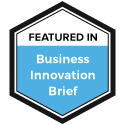
Mindfulness in the Workplace: A New Era of Leadership
Mindfulness in the Workplace: A New Era of Leadership
When relentless innovation, rapid technological advances, and the constant pressure to meet KPIs, mindfulness may seem like a luxury. But as Ram Ganesan, co-founder of Kaboom AI, highlighted in a recent episode of The Bliss Business Podcast, it is exactly what’s needed to foster sustainable success in today’s high-pressure business environments. Mindfulness is no longer a “soft skill” relegated to personal wellness — it’s becoming a critical leadership tool for those who want to build resilient, connected teams and maintain balance amidst the chaos of digital transformation.
Leading with Mindfulness
Ganesan’s journey as an entrepreneur, from his early ventures with Surion Technologies to his leadership at Kaboom AI, is rooted in an intentional focus on mindfulness. As Ganesan shared, the success of his businesses goes beyond profits; it’s about creating meaningful connections and fostering a culture where employees are valued not just for their output, but as whole human beings.
Mindfulness in leadership is about being fully present and connected with your team, customers, and yourself. Ganesan credits much of his success to his ability to be mindful in his approach to relationships — whether they’re with his team members or his customers. He understands that the work environment can be overwhelming, but by practicing mindfulness, he can guide his team with empathy and clarity. This allows them to feel supported, seen, and empowered to perform at their best.
The Balance Between Technology and Humanity
As Ganesan continues to lead Kaboom AI, he emphasizes the importance of balancing technological innovation with human connection. Kaboom AI is transforming customer success and relationship management by using AI to enhance — not replace — the human touch. While technology provides businesses with tools to stay efficient, Ganesan stresses that it should never overshadow the human element.
By integrating mindfulness into leadership practices, Ganesan ensures that his team members stay connected not only with their tasks but with each other. The mindfulness practices he encourages help to reduce stress, improve focus, and enable his team to think creatively in a fast-paced environment. This is crucial in a world where technology often accelerates the pace of work, making it easy to lose sight of what really matters — human relationships.
The Power of Intentional Leadership
One of Ganesan’s key takeaways from his entrepreneurial journey is the power of intentionality. Whether in business or personal life, success is rooted in being purposeful about every action. As Ganesan puts it, “You have to be very intentful” about the pursuit of happiness and balance in both work and life.
Intentional leadership means ensuring that employees are engaged and connected to the company’s mission. Ganesan actively promotes open dialogue, allowing employees to express their needs and concerns. This level of mindfulness in leadership creates a culture of transparency, where people feel empowered to contribute their best. It’s not just about meeting deadlines or hitting KPIs; it’s about fostering an environment where every individual can thrive both professionally and personally.
Building Empathy and Connection in a Fast-Moving World
One of the most refreshing aspects of Ganesan’s leadership is his commitment to empathy. He views his role as a leader not just through the lens of driving business growth, but through building strong, meaningful relationships with his team and clients. Ganesan often reminds his employees that success isn’t measured solely in monetary terms. For him, true success lies in creating a positive and supportive workplace where employees feel valued.
In a tech-driven world where data and algorithms often dominate decision-making, Ganesan’s approach reminds us of the importance of maintaining a human touch. Mindfulness and empathy go hand in hand in his leadership style, which has led to deeper connections within his organization and a more engaged team. By fostering these values, Ganesan ensures that his team not only achieves business success but does so with purpose and fulfillment.
Conclusion: Mindfulness as a Path to Sustainable Success
Ram Ganesan’s leadership journey highlights the profound impact of integrating mindfulness into the workplace. His emphasis on intentionality, empathy, and human connection has enabled him to build resilient, high-performing teams even in the most fast-paced environments. For businesses looking to thrive in the modern world, adopting a mindful approach to leadership is no longer an option — it’s a necessity.
As technology continues to evolve, the balance between innovation and humanity will define the success of future leaders. Ganesan’s insights remind us that while technology can enhance productivity, it is mindfulness, empathy, and authentic human connection that drive long-term, sustainable success in today’s business world.
Check out the conversation with Ram Ganesan on The Bliss Business Podcast
Originally Featured on The Bliss Business Podcast Blog










Recent Comments